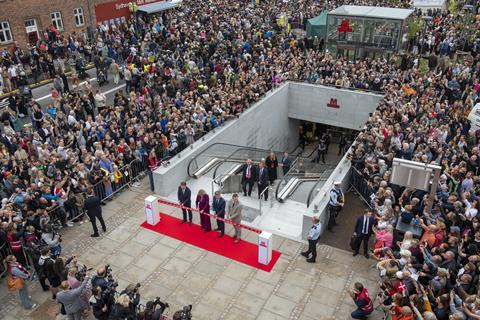
DENMARK: The southern extension of København’s automated metro Line M4 serving the Sydhavn and Ny Ellebjerg districts was formally inaugurated by King Frederik X on June 22.

The 5·7 km extension with five stations brings the capital’s four-line network to 43 route-km and 44 stations. It terminates at København Syd, where connections are provided with regional and S-bane services — the interchange was renamed from Ny Ellebjerg with the December 2023 timetable change. Intermediate stations are provided at Havneholmen, Enghave Brygge, Sluseholmen and Mozarts Plads.
The king was joined for a ribbon-cutting ceremony at Mozarts Plads by København’s Lord Mayor Sophie Hæstorp Andersen, the mayor of Frederiksberg Michael Vindfeldt and Transport Minister Thomas Danielsen. The event was attended by 6 000 people, including ambassadors from France, Austria, Italy, Portugal and Japan.

Under construction for six years at a total cost of DKr10bn, the extension is expected to be carrying 8 million passengers/year by 2030, according to metro authority Metrokselskabet. As with the rest of the metro, the line has been equipped with CBTC and train supervision systems from Hitachi Rail, supporting driverless operation to Grade of Automation 4.
The journey time between København Syd and Rådhuspladsen is 10 min, while a ride from Mozarts Plads to the M1/M2 interchange at Kongens Nytorv takes 11 min.

‘This is one of the days I will never forget’, said Andersen. ‘With each new metro station, we lift the city, make everyday life easier and give everyone the opportunity to get from A to B in one of the most climate-friendly modes of transport.’
‘It is always a historic day when new metro stations open’, added Metroselskabet CEO Carsten Riis. ‘We are very happy to finally be able to open the doors to passengers and welcome them to the Metro. With more metro in the capital, we not only ensure a stronger and more efficient traffic network in the capital, we also create new, fast connections from København to the rest of the region and the country.’
Danielsen agreed that København Syd would become ‘one of Denmark’s busiest stations’, given that it was now possible to change between the metro and inter-city, regional or suburban trains. ‘There are train connections on several floors, and it is an impressive building that is also both within the budget and on time’, he reflected.
According to Metroselskabet, the København metro carried 120 million passengers in 2023, an increase of 12 million from the previous year. The agency anticipates that ridership in 2024 will exceed 135 million.



